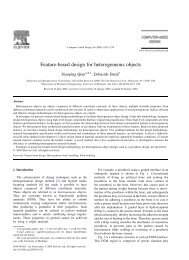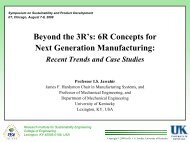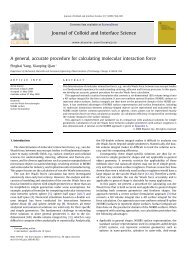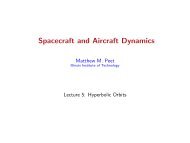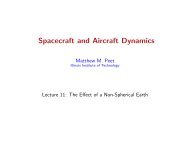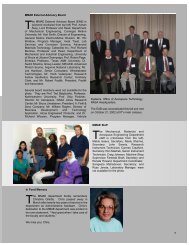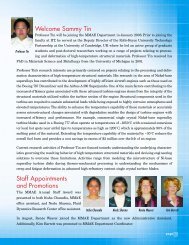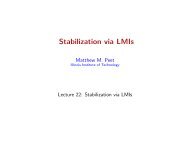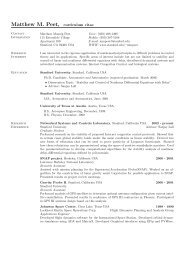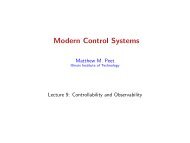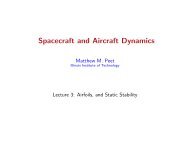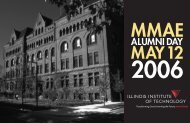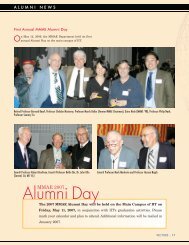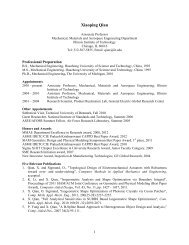Mechanical, Materials and Aerospace Engineering - Illinois Institute ...
Mechanical, Materials and Aerospace Engineering - Illinois Institute ...
Mechanical, Materials and Aerospace Engineering - Illinois Institute ...
You also want an ePaper? Increase the reach of your titles
YUMPU automatically turns print PDFs into web optimized ePapers that Google loves.
ILLINOIS INSTITUTE OF TECHNOLOGY<br />
VECTORS<br />
MMAE<br />
VECTORS MAGAZINE<br />
NOVEMBER 2006<br />
MECHANICAL,<br />
MATERIALS<br />
AND AEROSPACE<br />
ENGINEERING<br />
DEPARTMENT
T A B L E O F C O N T E N T S<br />
Message from the Chair . . . . . . . . . . . . . . . . . . . . . . . . . . . . . . . . . . . . . . . . . . . . . 1<br />
Research Highlights<br />
Multimodal Reverse <strong>Engineering</strong>:<br />
A New Paradigm for Shape Digitization . . . . . . . . . . . . . . . . . . . . . . . . . . . 2<br />
Magnetic Nano-Particles in Blood Flow:<br />
A Collaboration Between Fluid Mechanics <strong>and</strong> Medical Science . . . . 3<br />
Linking the Properties, Microstructure <strong>and</strong> Chemistry<br />
of High Performance <strong>Materials</strong> . . . . . . . . . . . . . . . . . . . . . . . . . . . . . . . . . . . 4<br />
How Much of Plastic Work is Converted into<br />
Heat in Metal Deformation? . . . . . . . . . . . . . . . . . . . . . . . . . . . . . . . . . . . . . . 5<br />
Electrically Driven Fluid Flows<br />
in Macro <strong>and</strong> Micro Scales . . . . . . . . . . . . . . . . . . . . . . . . . . . . . . . . . . . . . . . 6<br />
National Coalition for Manufacturing Innovation . . . . . . . . . . . . . . . . . . . . . .7<br />
Enhancement of MMAE’s Teaching Laboratories . . . . . . . . . . . . . . . . . . . . . . 8<br />
Department News . . . . . . . . . . . . . . . . . . . . . . . . . . . . . . . . . . . . . . . . . . . . . . . . . . 10<br />
Student News . . . . . . . . . . . . . . . . . . . . . . . . . . . . . . . . . . . . . . . . . . . . . . . . . . . . . .11<br />
Annual Research Poster Competition . . . . . . . . . . . . . . . . . . . . . . . . . . . . . . . 13<br />
Faculty <strong>and</strong> Staff News . . . . . . . . . . . . . . . . . . . . . . . . . . . . . . . . . . . . . . . . . . . . . 14<br />
Alumni News . . . . . . . . . . . . . . . . . . . . . . . . . . . . . . . . . . . . . . . . . . . . . . . . . . . . . . 17<br />
Where Are Our Alumni? . . . . . . . . . . . . . . . . . . . . . . . . . . . . . . . . . . . . . . . . . . . . 19<br />
Alumni Recognition Awards . . . . . . . . . . . . . . . . . . . . . . . . . . . . . . . . . . . . . . . . 20<br />
MMAE Spring 2006 Seminars . . . . . . . . . . . . . . . . . . . . . . . . . . . . . . . . . . . . . . . 22<br />
MMAE Fall 2006 Seminars . . . . . . . . . . . . . . . . . . . . . . . . . . . . . . . . . . . . . . . . . . 23<br />
History . . . . . . . . . . . . . . . . . . . . . . . . . . . . . . . . . . . . . . . . . . . . . . . . . . . . . . . . . . . .24<br />
Andrew Fejer Memorial Fellowship . . . . . . . . . . . . . . . . . . . . . . . . . . . . . . . . .27<br />
Why MMAE at IIT? . . . . . . . . . . . . . . . . . . . . . . . . . . . . . . . . . . . . . . . . . . . . . . . . . 28<br />
Who Are We? . . . . . . . . . . . . . . . . . . . . . . . . . . . . . . . . . . . . . . . . . . . . . . . . . . . . . . 29<br />
The cover symbols represent flow pattern of electrically driven liquid film <strong>and</strong> bubble deformation within a diverging electric field.
M E S S A G E F R O M T H E C H A I R<br />
The MMAE Department moved forward significantly<br />
in academic year 2005/2006 in every aspect of its<br />
mission (education, research, <strong>and</strong> service). MMAE<br />
enrollment continued to experience steady growth. The<br />
freshman class size reached 100, an increase of 20 percent<br />
compared to fall 2005. Total undergraduate enrollment this<br />
year reached 347, an increase of 18 percent compared to last<br />
year. Graduate enrollment also continued its growth, reaching<br />
194, an increase of 11 percent since last year (see page 10<br />
for more details). The Department added three new online<br />
graduate programs beginning this fall (see page 10 for more<br />
information).<br />
MMAE Department graduate programs in <strong>Mechanical</strong><br />
<strong>Engineering</strong> <strong>and</strong> <strong>Aerospace</strong> <strong>Engineering</strong> both ranked again<br />
among the top 50 programs in the nation, based upon U.S. News<br />
<strong>and</strong> World Report’s list of “America’s Best Graduate Schools.”<br />
External research funding in the department exceeded $3M last<br />
year. Among MMAE faculty, currently, 25 percent are fellows of<br />
professional societies <strong>and</strong> 20 percent are editors or associate<br />
editors of top journals in their corresponding fields. We have<br />
made significant progress toward establishing the National<br />
Coalition for Manufacturing Innovation, an IIT Armour College<br />
of <strong>Engineering</strong> initiative led by the MMAE Department<br />
(see page 7 for more information).<br />
I am very proud of <strong>and</strong> grateful to our alumni for responding<br />
to last year’s IIT $1M Matching Campaign. The MMAE<br />
Department received $1.25M in campaign funding to<br />
improve the state of our undergraduate teaching laboratories.<br />
More details are provided on page 8. Next year, we will<br />
be naming several of our undergraduate laboratories in<br />
honor of the major donors.<br />
MMAE faculty are committed to continuing their efforts<br />
to further improve the quality of our teaching <strong>and</strong> research<br />
(at both the undergraduate <strong>and</strong> graduate levels). MMAE<br />
undergraduate enrollment is expected to exceed 450 by 2011.<br />
We will maintain total graduate enrollment at 200, but focus<br />
on improving the quality of our graduate students. To maintain<br />
a 1/15 (faculty/undergraduate) ratio (as a private<br />
program), the number of faculty should reach 30 by 2011.<br />
Reaching a faculty of this size will tremendously impact our<br />
undergraduate <strong>and</strong> graduate programs. We will be able to<br />
offer new courses <strong>and</strong> maintain small classroom size. This<br />
increase in faculty size will significantly impact the department’s<br />
research program as well. Our plan is to attract two<br />
top senior faculty in the core areas of Advanced<br />
Manufacturing <strong>and</strong> <strong>Aerospace</strong> Systems. Subsequent hiring<br />
of faculty at the junior level will be linked to these two senior<br />
positions <strong>and</strong> MMAE research initiatives.<br />
In recognition of Professor Andrew Fejer <strong>and</strong> his many<br />
contributions to IIT, the MMAE Department is establishing<br />
the Andrew Fejer Memorial Fellowship (see page 27 for more<br />
information). In conjunction with this effort, next year we<br />
will initiate a new campaign to raise funds for graduate<br />
fellowships to attract highly qualified U.S. citizens <strong>and</strong><br />
permanent residents to our graduate programs. The United<br />
States is facing top competition in science <strong>and</strong> technology. To<br />
maintain global competitiveness, U.S. students need to<br />
complete degrees in engineering beyond the B.S. level. The<br />
campaign will launch in Spring 2007 <strong>and</strong> will target a $5M<br />
endowment that will support 10 top domestic graduate<br />
students per year.<br />
In closing, I again thank our alumni for their support.<br />
I am looking forward to yet another productive <strong>and</strong> successful<br />
year in the MMAE Department.<br />
Jamal Yagoobi<br />
yagoobi@iit.edu
R E S E A R C H H I G H L I G H T S<br />
Multimodal Reverse<br />
<strong>Engineering</strong>: A New Paradigm<br />
for Shape Digitization<br />
PROFESSOR QIAN<br />
The ability to obtain a digital geometric model directly<br />
from physical objects marks a revolutionary step in<br />
the information era. Three-dimensional (3D) digitization,<br />
a.k.a reverse engineering in the engineering field, is a process<br />
to create such three-dimensional computer models from a<br />
physical object. Recently the 3D digitization technology,<br />
fueled by the rapid progress of various 3D sensors such as<br />
laser scanners <strong>and</strong> 3D shape reconstruction algorithms, has<br />
seen explosive growth in its usage. Such reconstructed<br />
3D shape models have become increasingly important in a<br />
variety of applications such as product design <strong>and</strong> manufacturing<br />
in aerospace, automotive, <strong>and</strong> die <strong>and</strong> mold<br />
industries, patient-specific medical device design <strong>and</strong> analysis,<br />
as well as target recognition <strong>and</strong> scene underst<strong>and</strong>ing in<br />
homel<strong>and</strong> security <strong>and</strong> military applications.<br />
Qian <strong>and</strong> his research team believe their multimodal<br />
systems provide great opportunities to take a quantum<br />
leap in shape digitization automation <strong>and</strong> in surface<br />
quality improvement. Their research has been under<br />
the sponsorship of the National Science Foundation,<br />
National <strong>Institute</strong> of St<strong>and</strong>ards <strong>and</strong> Technology, General<br />
Electric, <strong>and</strong> General Dynamics-Advanced <strong>Engineering</strong><br />
Information Systems.<br />
Besides reverse engineering, Professor Qian <strong>and</strong> his research<br />
team at the Computational Design <strong>and</strong> Manufacturing<br />
Lab are also conducting other shape-related research in the<br />
broad area of computational design <strong>and</strong> manufacturing.<br />
For more information on this topic, please visit<br />
http://mmae.iit.edu/cadcam/<br />
Despite its growing usage <strong>and</strong> rising importance, current<br />
3D shape digitization has several bottleneck issues. For<br />
example, the digitization process is laborious <strong>and</strong> far from<br />
automatic. The reconstruction process is susceptible to<br />
sensor noise <strong>and</strong> data incompleteness, which commonly<br />
takes place in optical sensing due to occlusion <strong>and</strong> poor<br />
reflection conditions.<br />
To overcome these fundamental challenges, Professor<br />
Xiaoping Qian <strong>and</strong> his research team at the Computational<br />
Design <strong>and</strong> Manufacturing Lab in the MMAE Department<br />
are currently developing a novel multisensor shape digitization<br />
approach. They are integrating 3D sensors of different<br />
modalities into one platform. They use these multimodality<br />
sensors to provide better sensing coverage <strong>and</strong> more<br />
accurate measurement, which will result in autonomous,<br />
robust, accurate <strong>and</strong> complete shape digitization. These<br />
multimodality sensors, tactile, optical, acoustic, <strong>and</strong>/or<br />
X-ray based, possess different sensing capabilities for<br />
various part geometry <strong>and</strong> surface conditions, <strong>and</strong> different<br />
sensing characteristics such as resolutions <strong>and</strong> field of views.<br />
Consequently, accurate surface representation can<br />
be obtained by reducing/eliminating areas of missing data,<br />
<strong>and</strong> autonomous <strong>and</strong> robust segmentation can be achieved<br />
by using more accurate sensor data.<br />
2 | MECHANICAL, MATERIALS AND AEROSPACE ENGINEERING DEPARTMENT
R E S E A R C H H I G H L I G H T S<br />
Magnetic Nano-Particles<br />
in Blood Flow: A Collaboration<br />
Between Fluid Mechanics <strong>and</strong> Medical Science<br />
PROFESSOR REMPFER<br />
The research group of Professor Dietmar Rempfer at the<br />
Fluid Dynamics Research Center (FDRC) of the MMAE<br />
Department at <strong>Illinois</strong> <strong>Institute</strong> of Technology (IIT) is entering<br />
the field of bio-fluid dynamics with a research project<br />
that may ultimately lead to the development of compact <strong>and</strong><br />
highly efficient separation devices that can selectively <strong>and</strong><br />
rapidly remove blood-borne toxins or excess drugs from the<br />
blood circulation, or alternatively direct drugs inserted into<br />
the blood flow to a specific area of the body in order to implement<br />
targeted drug therapy. The research under this project<br />
is carried out jointly at IIT <strong>and</strong> the University of Chicago. At<br />
IIT, Professor Rempfer’s team is primarily focusing on<br />
numerical simulations <strong>and</strong> the establishment of theoretical<br />
test modules useful for subsequent evaluation in flow<br />
models. At the University of Chicago, a team headed by Dr.<br />
Rosengart at the Biological Sciences Division <strong>and</strong> the<br />
Departments of Neurology <strong>and</strong> Surgery (Neurosurgery) will<br />
perform validating flow experiments <strong>and</strong> be responsible for<br />
the magnetic separator prototype design.<br />
In contrast to magnetic separators employed in industry <strong>and</strong><br />
for in vitro purposes, the design <strong>and</strong> development of a separator<br />
technology for high-efficiency capture of magnetic<br />
spheres from the human blood stream (i.e., blood is briefly<br />
circulated through an extracorporeal tubing system) as<br />
studied here will incorporate strict biomedical boundary<br />
conditions such as biocompatible magnetic carriers, externally<br />
applied magnetic fields, avoidance of activation of the<br />
blood clotting cascade, <strong>and</strong> portability to facilities out-ofhospital<br />
<strong>and</strong> for emergency deployment.<br />
A typical magnetic filtration unit as considered in this project<br />
will consist of an assembly of ferromagnetic elements<br />
attached to an external limb of the body (e.g. wrapped<br />
around an elbow as shown in Fig.1). An ideal unit would be<br />
designed in such a way that the collection of carriers in a<br />
single pass is maximized while its weight is restricted to a<br />
few hundred grams.<br />
Fig. 2 shows an example of a magnetic separator design<br />
together with some results from numerical simulations that<br />
have been performed for this project.<br />
Fig. 1 Conceptual rendition of<br />
application of a designed portable<br />
magnetic separator<br />
As part of the efforts, the combined role of a permanent block<br />
magnet <strong>and</strong> ferromagnetic elements of smaller size (not<br />
necessarily permanently magnetic, but able to reach larger<br />
magnetizations <strong>and</strong> thus larger magnetic fields) is investigated<br />
(Fig. 2). This hypothetical single-pass magnetic<br />
separation system will be further investigated using a<br />
theoretical model developed in Professor Rempfer’s group.<br />
The parameters considered in this study include the blood<br />
velocity, the presence, number <strong>and</strong> dimensions (height) of the<br />
ferromagnetic prisms <strong>and</strong> the ferromagnetic properties of<br />
both ferromagnetic prisms <strong>and</strong> permanent magnet.<br />
Fig. 2 Schematic of the magnetic<br />
separator demonstrated, <strong>and</strong> typical<br />
magnetic drug carrier trajectories<br />
obtained from simulations as they<br />
flow through the tubing in contact<br />
with the magnet separator (b).<br />
Fig. 3 Magnetic Separator design<br />
example 2 (3D), composed of a<br />
permanent donut magnet <strong>and</strong> ferromagnetic<br />
rings (inside the bore).<br />
The ferromagnetic rings used here<br />
are made of Fe/Fe alloys. The slice<br />
is on y-z plane <strong>and</strong> passes through<br />
x=0. The colors represent local<br />
magnetic field strength.<br />
VECTORS | 3
R E S E A R C H H I G H L I G H T S<br />
Linking the Properties,<br />
Microstructure <strong>and</strong> Chemistry<br />
of High Performance <strong>Materials</strong><br />
PROFESSOR TIN<br />
<strong>Materials</strong> scientists <strong>and</strong> engineers are constantly seeking<br />
to develop novel new materials <strong>and</strong> improve upon existing<br />
ones in order to promote technological growth. For<br />
example, remarkable improvements in the performance <strong>and</strong><br />
efficiency of advanced turbine engines for aerospace applications<br />
can be attributed to the integration of innovative<br />
materials in the high-pressure turbine or “hot stage” of the<br />
engine. Refinement of alloy chemistries combined with<br />
advanced manufacturing processes designed to control the<br />
grain structure of the turbine blade components have resulted<br />
in a ~1.4% reduction in specific fuel consumption. For a large<br />
commercial jetliner, such as a Boeing 777, this corresponds to<br />
a fuel savings of over 200,000 gallons per year <strong>and</strong> an annual<br />
4 million pound reduction of harmful CO 2 emissions!<br />
Professor Tin’s research group is currently working on novel<br />
methods to develop new, stronger materials, <strong>and</strong> extend the<br />
temperature capability of high performance alloys for aerospace<br />
applications. In order to develop new materials or<br />
enhance the properties of existing materials, one first must<br />
underst<strong>and</strong> the fundamental mechanisms that govern failure<br />
of the component. This requires detailed characterization<br />
of the microstructure <strong>and</strong> knowledge of the intrinsic behavior<br />
of the material. Linking the properties, microstructure<br />
<strong>and</strong> chemistry of high performance materials is extremely<br />
important as it enables us to devise engineering solutions to<br />
overcome inherent material limitations. Professor Tin is<br />
currently applying these principles towards the development<br />
of new Ni-base superalloys that will be utilized in ultra-efficient<br />
gas turbine engines like those on the Boeing 787<br />
Dreamliner <strong>and</strong> Airbus A350XWB.<br />
In collaboration with Professor Philip Nash <strong>and</strong> the research<br />
staff within the MMAE Department’s Thermal Processing<br />
Technology Center (TPTC), Professor Tin has established a<br />
High Temperature Structural <strong>Materials</strong> Laboratory<br />
(HTSML) at IIT. Housed within the HTSML is a new<br />
Micro<strong>Materials</strong> NanoTest platform capable of measuring<br />
critical mechanical properties, such as hardness <strong>and</strong> reduced<br />
modulus, corresponding to the discrete constituent phases<br />
present in the microstructure at temperatures up to 750°C.<br />
This NanoTest platform enables us to perform detailed characterization<br />
of the micro-mechanical properties of virtually<br />
any material on the nano-scale. This particular system<br />
possesses the ability to conduct nano-indentation tests at<br />
elevated temperatures <strong>and</strong> is the first system with this capability<br />
to be established in the U.S. The only two other<br />
systems with this unique capability are located within<br />
Europe. This system consists of a nano-indentation unit with<br />
a high temperature furnace for heating the specimen <strong>and</strong><br />
separate heating system for maintaining the temperature of<br />
the diamond or sapphire tip. The system is enclosed within<br />
an environmental chamber (



